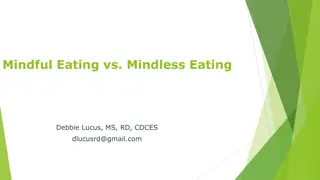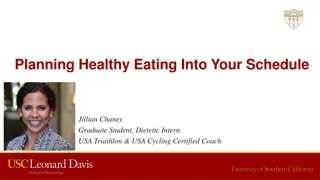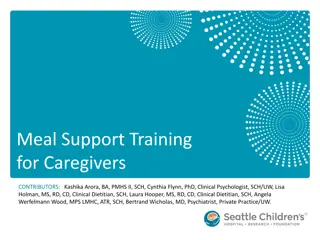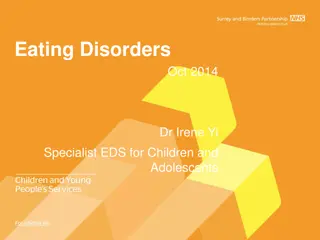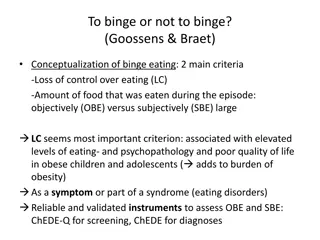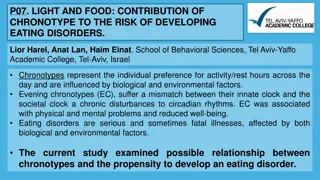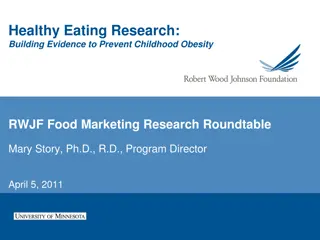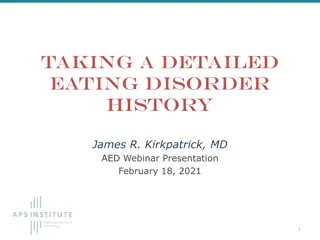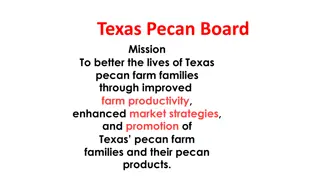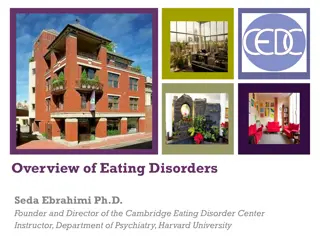Mindless Eating Mini-Research Study at Texas Roadhouse
A mini-research experiment conducted by Makayla Massie at Texas Roadhouse to observe the eating behaviors of subjects with complementary bread rolls. The study aimed to determine if individuals consuming multiple bread rolls would still eat their full entrees. Findings showed varied consumption patterns among subjects, highlighting the impact of free and unlimited food on overeating tendencies.
Download Presentation

Please find below an Image/Link to download the presentation.
The content on the website is provided AS IS for your information and personal use only. It may not be sold, licensed, or shared on other websites without obtaining consent from the author. Download presentation by click this link. If you encounter any issues during the download, it is possible that the publisher has removed the file from their server.
E N D
Presentation Transcript
MINDLESS EATING MINI- RESEARCH EXPERIMENT Makayla Massie
Describe the topic and methods of the mini-research study. I have conducted my mini-research experiment at Texas Roadhouse. My family and I went to Texas Roadhouse for dinner, and they gave us complementary, unlimited bread rolls with cinnamon butter. I wanted to see how many bread rolls each person would eat (since they are free and unlimited) even though we all ordered entr es as well. I also wanted to see how much of their entr e each subject would eat based on how many bread rolls they ate. I was trying to answer these questions: Will the subjects eat more than one serving of bread rolls? If so, will they still eat their full entr es?
Why is researching this particular topic and research relevant to the general population? I believe that this particular topic is relevant to the general population because many people will overeat if food is unlimited and free or no extra cost (ex. buffets, bread rolls at Texas Roadhouse, chips and salsa at Mexican restaurants, breadsticks at Olive Garden, etc.). If food is readily available and within reach, people are more likely to overeat on these appetizers before their entr e ever comes. The fact that these foods are free adds to the temptation and likelihood that people will eat it. I think researching this topic brings awareness to portion control and eating in excess.
Who was studied? Both males and females between ages 2 to 57 were studied. Subject #1 Female, 57 years old Subject #2 Male, 24 years old Subject #3 Female, 24 years old Subject #4 Female, 30 years old Subject #5 Male, 36 years old Subject #6 Male, 7 years old Subject #7 Male, 2 years old
What was the hypothesis? If customers eat more than one serving of bread rolls, then they will still eat at least 80% of their entr e.
State the studys methods. I observed my family (seven subjects) eating dinner at Texas Roadhouse. I recorded the number of bread rolls that my family ate while we were waiting for our entr es, and whether or not it was more than one serving (given that one serving = one bread roll). I then recorded an approximate percentage of how much each person ate of their entr e.
What were the findings of the research? Subject #1 Ate 2 bread rolls and 90% of entr e Subject #2 Ate 2 bread rolls and 85% of entr e Subject #3 Ate 3 bread rolls and 95% of entr e Subject #4 Ate 3 bread rolls and 95% of entr e Subject #5 Ate 2 bread rolls and 90% of entr e Subject #6 Ate 1 bread roll and 70% of entr e Subject #7 Ate 1 bread roll and 75% of entr e
Were results similar throughout the subjects tested? Why or why not? The results were similar throughout the seven subjects tested. Considering one bread roll to be one serving, five out of the seven subjects ate more than one serving of bread rolls. Even though they ate more than one serving of bread rolls, each of these five subjects still ate majority of their entr e as well. I think this was because the bread rolls were within reach and no cost, and we had to wait a while before we got our entr es. I think they ate majority of their entr es for the same reason of it being in front of them, as well as not wanting to waste food.
Did the findings match the hypothesis? Why or why not? Yes, the findings did match my hypothesis. My hypothesis was proven true because the subjects that ate greater than one serving of bread rolls each ate greater than 80% of their entr e as well. Based on the videos of Wansink s research, I thought that if the unlimited bread rolls were within reach, each subject would eat more than one serving, and still eat majority of their entr e. I think this was because if people have food in front of them, they are most likely going to eat it whether or not they are hungry or full.
What observations/opinions can you make regarding the results and the Longwood University population? I did not observe Longwood University students in my mini-research experiment, so I cannot make observations or opinions on this population from my findings. However, I can make observations and opinions on my family based on my results. I found that even though they knew their entr es were coming, because they were hungry, had bread rolls within reach, and knew the bread rolls were free and unlimited, they ate more than the serving size of bread rolls. Though they may have started to fill up on bread rolls, they still ate majority of their entr es as well. I can conclude that people will most likely eat the food that is in front of them regardless of their satiation. I can also conclude that more education on portion control, especially when at restaurants, is needed.
How can these results help to change Mindless Eating? These results definitely show what mindless eating is. Many people may not be familiar with this concept, so these results can help to explain it. These results also show the importance of being aware of your own mindless eating and portion control. I think in order to change mindless eating, it is important to first understand it and then stay self aware of your own eating habits.





